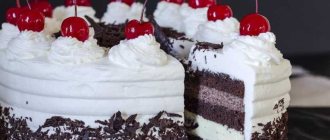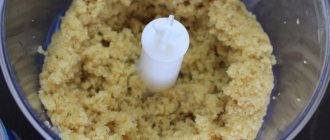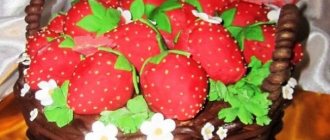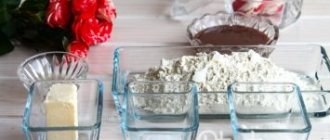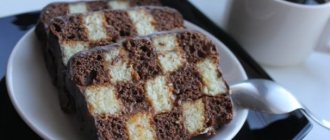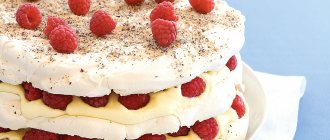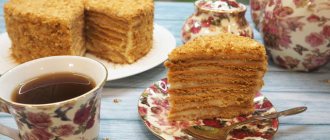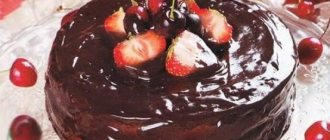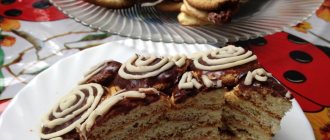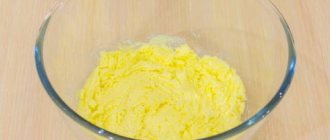Created by Australian confectioners a century ago in honor of the incredibly talented Russian ballerina Anna Pavlova, the Pavlova meringue cake resembles a snow-white tutu. The light, airy, lacy dessert is associated with the Russian dancer who conquered the world with her unsurpassed talent, elegance and grace. True, New Zealand confectioners claim that they are the authors of the original dessert. Let’s not argue, but rather let’s try to bake this confectionery miracle. The cake is made from French meringue, whipped cream and strawberries, with a crispy crust on the outside and a soft meringue inside that melts in your mouth. According to eyewitnesses, Anna Pavlova really liked this cake and enjoyed it during her tour in Australia and New Zealand. The recipe is ingenious and so simple that you can easily prepare Pavlova cake at home, even without any special culinary training.
Preparing ingredients for dessert
To prepare Pavlova cake at home, we will need the following products: chilled egg whites, sugar or powdered sugar, 33% fat cream, vanillin, wine vinegar and corn starch, which can be replaced with potato starch (although you will need 2 times less potato starch). If you don't like vinegar, substitute lime or lemon juice, although some recipes combine vinegar with citrus juice. Instead of cream, you can use various cream cheeses such as mascarpone or full-fat sour cream. For decoration you will need powdered sugar, chocolate, nuts or confectionery powder.
By the way, it is quite appropriate to replace whipped cream with light low-calorie yogurt, mixing it with honey instead of sugar, or even make unsweetened cream, because the cream itself is slightly sweet, and the fruits provide additional sweetness. Instead of cream, you can also use fruit sorbet or thick berry syrup. Of course, this will no longer be a classic cake, but you don’t have to worry about the figure.
Dessert history
This is the case with many iconic dishes, in particular there is a small battle that rages over Caesar salad. The dispute over the authorship of Anna Pavlova's dessert involves Australia and New Zealand, which say that the famous meringue dessert was the first to appear in their regions.
The only point of agreement between the two countries: Pavlova was created in honor of the famous ballerina Anna Pavlova, who actually made several tours in Oceania. Chef Bert South of the Esplanade Hotel in Perth, Australia, maintained throughout his life that he developed this recipe in 1934.
But, according to Keith Mooney, Anna Pavlova's biographer, the dessert was created in 1926 in Wellington (the capital of New Zealand) by a young chef in love with the ballerina. In any case, neither Bertha nor Wellington's enamure were the first to top meringue with whipped cream and fresh fruit. In The Story of Pavlova: A Fragment of New Zealand's Culinary History, culinary anthropologist Helen Leach explains that she found several recipes similar to Pavlova in old New Zealand cookbooks and magazines. Pavlova then becomes the national dessert in Oceania!
Almost 100 years later, the Australia-New Zealand Pavlova row is still very much alive. In 2007, New Zealand insurance company NZI released a commercial in which the star of the video was a red fruit meringue. This is called adding fuel to the fire.
How to beat egg whites for French meringue
Beat the whites only in a dry and clean container, since even a drop of moisture or fat can interfere with the process and the foam will not be as strong as it should be. Some housewives pre-degrease the dishes with lemon juice and wipe them dry. Confectioners have different opinions about the temperature of the proteins for meringues - some believe that it is better to pre-cool them, while others use the proteins at room temperature. Only one thing can be said for sure: cold eggs beat better and faster, and slightly warm whites give a softer foam. A pinch of salt is often added to the proteins to obtain a fluffy foam. In general, all housewives have their own culinary subtleties and secrets.
The whites for the Pavlova cake need to be whipped in a mixer - first at low speed, and then increasing the speed and gradually adding powdered sugar, literally a tablespoon at a time. Sugar is always added only after the peaks have become stiff, otherwise the whites will be difficult to beat. Properly whipped meringue holds its shape well, it is quite dense and at the same time very smooth and airy. After sugar, you can carefully add other products to the protein mass, mixing them carefully and not very intensely.
The tender center is the highlight of the cake: how to bake meringue
You can make one large cake, bake several mini-cakes, or make dessert in the form of small cakes. Protein products are usually baked on baking paper to prevent sticking. Draw a circle of the desired shape on the paper, lightly sprinkle the paper with cornmeal and spread the protein mixture evenly, leveling it with a spoon. To make the cake easier to form, you can use a springform pan. The edges of the airy meringue should be slightly higher to form a cup, which is subsequently filled with cream. You can also make a very deep vase that looks like a volcano with a crater, decorate the surface of the meringue with a relief pattern, or give the cake an original shape using a pastry syringe.
The meringue is baked in two stages - the first stage lasts 5 minutes, temperature - 140–150 °C. This is necessary for the meringue crust to set and become crispy. At the second stage, the meringue is prepared for about half an hour at a temperature of 120 °C. You can bake the cake in another way - heat the oven to 200 °C, then reduce the heat to 90–100 °C and bake the meringue for another 1.5–2 hours. The most suitable baking mode is bottom-up with convection, since in this case the meringue will dry well and remain soft inside. Cooking time depends on the features of the oven and the size of the meringue, but there are certain signs that you can focus on. If the meringue seems too wet, then turn off the heat too early, and if drops of syrup appear on its surface, you have dried out the dessert.
Do not open the oven while the cake is baking, otherwise the meringue will settle, be patient. After turning off the oven, do not immediately take out the baking sheet, let the cake stand for a while, cool down and “come to its senses.”
Cream and juicy fruits: decorate the cake
While the cake is cooling in the oven, beat the cooled heavy cream with a mixer or whisk, but do not overdo it or the butter will separate from the whey. The right buttercream always turns out light, tender and dense.
Place the baked and cooled meringue on a plate, cover the top and sides with buttercream and garnish with plenty of strawberries, although you can use any berries and fruits. Place mint leaves on the berries, pour fruit puree or chocolate sauce over the cake, sprinkle with powdered sugar or grated chocolate - you can decorate the dessert in different ways, it all depends on your imagination. Some confectioners decorate the dessert with chocolate painting made from white and dark chocolate, and use nuts and candied fruits. Serve the finished dessert immediately. Pavlova cake should be eaten immediately, preferably without leaving it for tomorrow.
Forming a roll
Spread the buttercream evenly over the entire surface of the cooled crust. Cut thawed or fresh strawberries into small pieces. Cut the raspberries in half. Use blueberries whole. Sprinkle the berries over the crust as evenly as possible.
It’s good to wash often: myths about shampoo and hair care that only harm
Rare shot: Viktoria Isakova showed her grown-up daughter from Yuri Moroz (new photo)
Lost weight: what Sofia Tarasova sacrificed for the sake of “VIA Gra” (new photos)
Lift the baking paper from one edge of the cake. Begin to carefully roll the roll, placing the edge of the paper in place. Roll the cake into a roll, pour melted chocolate over it and decorate with berries to your liking.
Trim the edges of the roll with a knife to make it look more attractive. Place the finished roll in the refrigerator to soak for 1 hour.
Pavlova cake: cooking secrets
For the cake, you need to beat the whites very well to get a thick and strong foam, and instead of sugar it is better to use powdered sugar. Sometimes salt is added to the protein mass for better whipping. The classic pavlova recipe calls for cornstarch and vinegar, and these ingredients are very important because they create the crispy crust of the meringue, which hides the soft and fluffy cream inside. This is the main difference between the dessert and ordinary meringue. Some recipes mention flour, which is added in small quantities to the proteins. Thanks to it, the dough becomes more plastic, you can create the most bizarre shapes from it or hide the filling inside.
The cake can be baked either whole or in portions, and decorated with strawberries, passion fruit, kiwi or raspberries. In general, any fruit and berries, but the classic combination is strawberries and passion fruit. The cake can be decorated with mint or lemon balm leaves for freshness and aroma.
And one more secret - assemble the cake right before serving, otherwise the layers of meringue will be saturated with berry or fruit juice too quickly, soften, and the juice will flow, as a result of which the dessert will look unattractive. It is advisable to eat the cake immediately, as the next day it becomes tasteless. But it is recommended to bake the meringue in advance. For example, the day before the planned tea party, so that the cookies dry out and become crispy.
Pavlova cake: step-by-step recipe
There are about 700 recipes for this meringue cake in the world, and you can master many variations of its preparation. But first, let's get acquainted with the basic, classic recipe, based on which you can experiment in the future.
Ingredients: proteins - 6 pcs., powdered sugar - 300 g, wine vinegar - 1.5 tbsp. l., corn starch - 4 tsp, lemon juice - 1 tsp, vanillin - on the tip of a knife, cream (35% fat) - 350 ml, powdered sugar - 4 tsp, berries and fruits - to your taste.
Cooking method:
1. Separate the whites from the yolks.
2. Beat the egg whites until they form stiff peaks.
3. Add powdered sugar and continue beating.
4. Combine the protein mass with corn starch, vinegar, lemon juice and vanilla.
5. Stir the dough well.
6. Preheat the oven to 120°C and line a baking tray with baking paper.
7. Spoon the meringue into a bowl with the edges raised.
8. Bake the crust for about 1.5 hours until it becomes dense.
9. Turn off the heat and let the meringue cool in the oven.
10. Whip the cream with powdered sugar until thick.
11. Fill the well in the bowl with the resulting cream.
12. Decorate the cake with any berries and fruits to your liking.
Cut the cake and enjoy the delicate dessert, feeling how pleasantly crunchy the meringue is with a juicy and soft filling reminiscent of fresh marshmallows.
Pavlova cake and the secrets of meringue
If you couldn’t make meringues, now you’ll definitely succeed! This airy delicacy is easy to prepare, and if you add cream and fruit, this dessert will become an exquisite table decoration!
Ingredients for “Pavlova Cake and Meringue Secrets”:
- Egg white - 1 pc.
- Powdered sugar - 80 g
- Cream (from 30%) – 200 ml
- Berry - to taste
Cooking time: 120 minutes
Number of servings: 3
Recipe for “Pavlova cake and the secrets of meringue”:
1. The most important thing is to carefully separate the whites from the yolks so that nothing unnecessary gets into the protein mass. 2. The mixing bowl and whisk should be dry and clean, preferably chilled. You can degrease them with vinegar. 3. Proteins should also be cold. 4. It is better to use powdered sugar, because it dissolves better. Take 60-65 grams for one protein. 5. It is better to start whipping at minimum speed, gradually increasing it. 6. Add powdered sugar in small portions, whisking continuously. 7. The protein mass must be whipped to stiff peaks. 8. Bake meringues at low temperature. Baking time depends on the oven and the size of the meringue and is 1.5-3 hours.
So, let's prepare the meringue. Meringue is the protein mass from which meringues will be baked. Beat the egg whites at medium speed into a thick foam. Gradually add powdered sugar, then beat at high speed for about 5 minutes until stiff peaks form. Our goal is an elastic and smooth meringue. If you turn the whisk or bowl upside down, the meringue should not change shape.
Transfer the finished mixture into a pastry bag or bag and place the “nests” on a baking sheet covered with parchment or a silicone mat.
Bake in the oven at 50-60 degrees for 1.5-2.5 hours. If the oven is gas, then open the door slightly. You need to focus on your oven; you can increase the temperature to 100 degrees. When the base is dry (you can tell by tapping it or tasting it), leave it in the oven until it cools completely. Beat the cream with powdered sugar to taste and pipe it into meringue pieces using a pastry bag, decorate with berries or fruits.
If the meringue darkens or cracks, the baking temperature is too high. You can use sugar, it will work too, you just need to beat it longer. The preparations can be made in advance; they store well in an airtight container for 2 weeks. Add coloring if desired. Bon appetit!
Chocolate Pavlova cake: recipe with photos
An incredibly delicious cake for chocolate lovers and simply those with a sweet tooth. Preheat the oven to 150 °C, while whisking 3 egg whites, gradually adding 175 g of sugar - about 1 tbsp. l. Add 4 tbsp to the prepared whipped whites. l. cocoa powder and stir well.
Cover a baking tray with baking paper and form two meringues from the egg white mixture. Bake the meringues for an hour until they are firm enough, then turn off the oven and let the meringue cool.
Whip 200 ml of heavy cream with 50 g of powdered sugar and assemble the cake, connecting the meringues together with cream. Fill the finished meringues with cream. Instead of buttercream, you can use creme fraiche or sorbet. Decorate with berries of your choice and sprinkle with grated chocolate. Chocolate meringue cake is a real culinary masterpiece!
This delicacy is so beautiful and tasty that it is often prepared for the holidays. It is not surprising that the world's largest Pavlova was prepared in 2005 by students at the Eastern Institute of Technology in New Zealand. The length of the cake was 65 meters, and it took about 5,000 egg yolks, 150 kg of sugar and cream to make it. Surprisingly, it was eaten instantly; the next day there was nothing left. May your dessert suffer the same fate. Enjoy your tea!
How to make Pavlova cake at home
So, let's begin! The rule for making meringue is two parts sugar for one part protein. There is no point in talking about the number of eggs, since they are all different. It's nice to have a kitchen scale at home. Accuracy is a good result!
Go ahead. You all know that squirrels are afraid of fat. This means that when separating eggs, be careful so that not a drop of yolk gets into the whites. Well, the dishes are clean and dry.
Many people beat the meringue for Pavlov in the usual way. I don't mind. But today I will prepare Swiss meringue for Pavlov. My practice has shown that the protein whips better and during the depositing process the relief is clear and the meringue does not flow.
And one more small observation. It is better to take old squirrels. That is, I often prepare custard with yolks and the whites huddle in the refrigerator for a couple of days. I used them for today’s cake. This, of course, is not necessary, but what if!
What is Swiss meringue? This is heating the protein with sugar in a water bath. I'll show you everything below.
We build a water bath. The top bowl should not touch the water.
Place over medium heat and, while constantly stirring the whites, ensure that the sugar is completely dissolved.
This is what the mass looks like.
Pour it into the mixer bowl and start beating. We start beating at low speeds and gradually increase them to maximum speed.
When the meringue is whipped, add starch. It's better to sift it.
And then there’s vinegar. After adding vinegar or lemon juice, the meringue will thicken even more. It will become dense and glossy. Yes, mix the meringue with starch and vinegar at low speed, just a couple of seconds.
Look, this is such a stable meringue.
To deposit cakes, I recommend using a closed star attachment. I like to plant marshmallows with this attachment. In general, with the nozzle number “1” we plant nests, and with number “2” - this is an open star - we fill them with cream.
Line the baking sheet with parchment in advance and place the “nests”.
Preheat the oven to 180ºC and as soon as you put the meringue in the oven, immediately reduce it to 100ºC.
A little addition from me. I dried the meringue in a small oven, so I dried it at 90ºC. Drying time depends on your oven. In my oven it took 1 hour and 10 minutes. Do not open the door while the oven is operating!
How to tell when Pavlova is ready? After the time has passed, open the oven and try to move it. They should move freely. Don't rush to take them out of the oven. Let them cool together in the oven with the door open.
After cooling, you can fill with cream.
In my opinion, I have not yet tried it better than cream cheese cream for Pavlova. If it's quick, then whipped cream and lots of berries.
I'll make my favorite cream cheese based cream. This is cream, cream cheese and a little powdered sugar.
Place the cream and powdered sugar into a blender bowl and beat until soft peaks form.
Next, add the cream cheese and beat for a couple more seconds. The result is a dense, airy cream.
I also need berries and mint for the pavlova cakes. Choose berries in season.
Before filling the cakes with cream, it will be better if you first fill the cakes with lemon or orange curd. Oh, it's a bomb. I was in such a hurry that I lost sight of him))))
Berries on any dessert are always a win-win!
Look how beautiful and easy this dessert is!
Well, as promised, crispy crust and tender soufflé inside! Friends, this cake is worth trying!
Well, and the last thing - how to store Pavlova cake? Since Pavlova cakes begin to melt upon contact with soft cream, their shelf life will be from 2 to 4 hours. However, they can last longer in the refrigerator. No, they don’t spoil, it’s just that this crispy crust that we achieved begins to melt.
So if you're making these Pavlova cakes and want them to last longer, there's a little secret. Did you see the chocolate in the photo with the ingredients? Yes, it doesn't just lie there. It is he who will save Pavlov's cakes from moisture. To do this, melt a piece of chocolate, stir well with a silicone spatula and let it cool to room temperature. Then we take the cooled cake and try to carefully grease the place where the cream will be with chocolate. We set them aside so that the chocolate hardens and that’s it, we don’t have to worry about our cream pies!
This is the simple and reliable method I use to deliver delicious Pavlova cake to the customer!
Friends, I wish you all the best and good luck in the kitchen! If you have any questions, write, I will answer them all!

